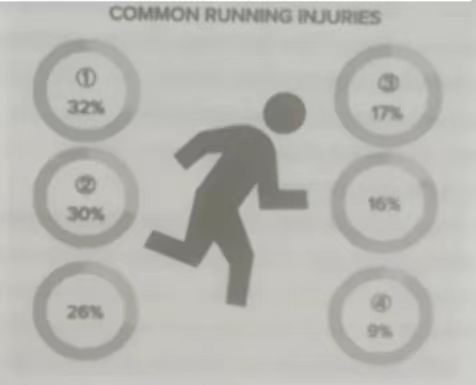
Running is a great form of exercise. However, running under ce rtain conditions can cause a variety of injuries.
The National Running Association recently released the results of its latest survey on common running injuries , as illustrated in the picture on the above. According to the survey results, the most reported cases are related to knee injury and muscle pull. With the former occurring a little less frequently. About a quarter of the respondents say they have had plantar fascitis( 筋膜炎 ). The number of respondents suffering from Achilles tendonitis(跟腱炎) or shin splints in nearly twice that of those with stress fracture, which is also what fewest respondents report.
There are two main causes of running injury: structural imbalance and training volume. Structural imbalance occurs when a certain muscle group is weak and requires other muscle groups to help. The body adapts to stresses and becomes stronger. This is the basic principle of training. However, if you push too fast or run too far, you can stress the body in such a way that it never has time to fully recover. Training progression and moderation are the keys to avoiding overuse injury. Here are several ways to avoid running injury.
Prepare your body for running by walking.
Understand your body type and be patient
Follow a sensible training plan or find a coach.
Wear the right shoes.
The cause of the injury is not easy to diagnose. For example, a foot problem can cause a problem in the knees or back. Finding and treating the cause of a running injury is the job of a trained doctor. More importantly, listen to your body and recognize the signs of over-training so that you can avoid running injury.
Which group of injuries best fits the blanks numbered (1),(2),3) and (4) in the picture?
A.(1) knee injury; (2) muscle pull; (3) stress fracture; (4) shin splints
B.(1) muscle pull; (2) knee injury; (3) stress fracture; (4) Achilles tendonitis.
C.(1) knee injury; (2) muscle pull; (3) shin splints; (4) stress fracture
D.(1) muscle pull; (2) knee injury; (3) Achilles tendonitis; (4) stress fracture答案:D According to the passage, which of the following leads to structural imbalance?
A. Using some muscles more intensely than others.
B. Training weak muscles more often than strong ones.
C. Adapting your body to stresses slowly.
D. Giving your body little time to recover.答案:A According to the passage, if you want to find out why your back and knees hurt after running, you had better _.
A. turn to a coach for help
B. consult a trained doctor
C. understand your body type first
D. wear another pair of running shoes答案:B
